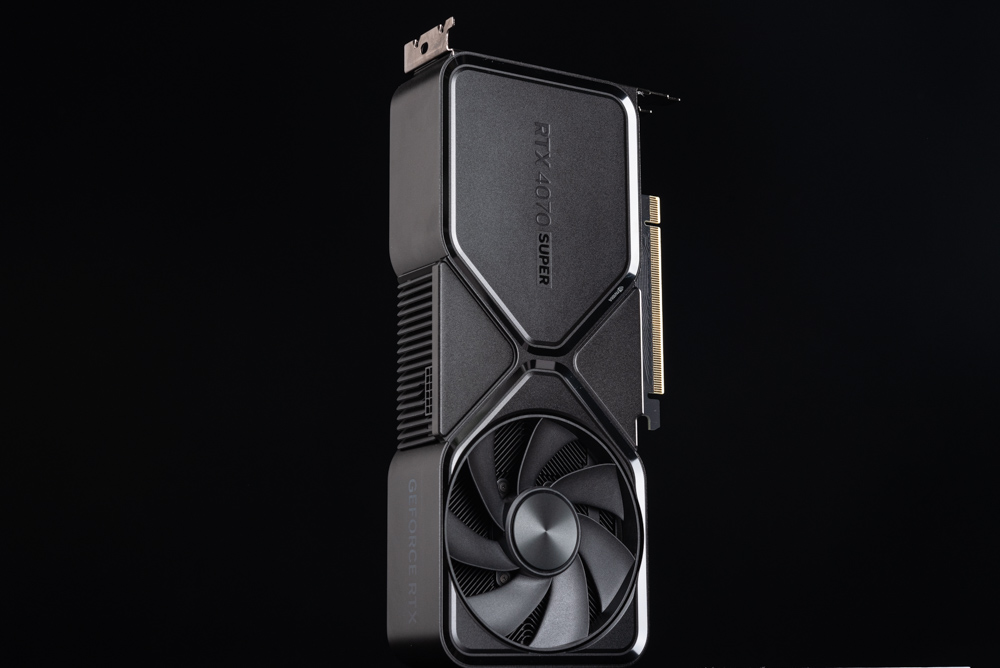
The NVIDIA RTX 40 SUPER Series, consisting of the GeForce RTX 4080 SUPER, RTX 4070 Ti SUPER, and RTX 4070 SUPER, offers enhanced gaming and creative capabilities. The RTX 4080 SUPER, priced at $999, is designed for 4K gaming and will be available from January 31. The RTX 4070 Ti SUPER, at $799, is ideal for high frame rates at 1440p and up to 4K, and it will be available starting January 24. Lastly, the RTX 4070 SUPER, priced at $599 and available from January 17, features 20% more cores than the RTX 4070 and is faster than the RTX 3090. These GPUs are built on the Ada Lovelace architecture, offering up to 52 shader TFLOPS, 121 RT TFLOPS, and 836 AI TOPS. They support AI-powered Deep Learning Super Sampling (DLSS) and ray tracing, enhancing visual quality in games like Diablo IV, Pax Dei, and Horizon Forbidden West.
NVIDIA Revolutionizes Gaming with New RTX 40 Super Series: Features and Prices Revealed
The NVIDIA RTX 40 Super series, featuring the new RTX 4070 Super, RTX 4070 Ti Super, and RTX 4080 Super graphics cards, showcases significant updates and enhancements. The RTX 4070 Super, launching on January 17, and the RTX 4070 Ti Super, debuting on January 24, are priced at $599 and $799 respectively. The RTX 4080 Super, set for release on January 31, is notably priced at $999, which is $200 less than the initial price of the RTX 4080. This pricing strategy makes the RTX 4080 Super more affordable compared to its predecessor while maintaining the price points for the other models in the series.
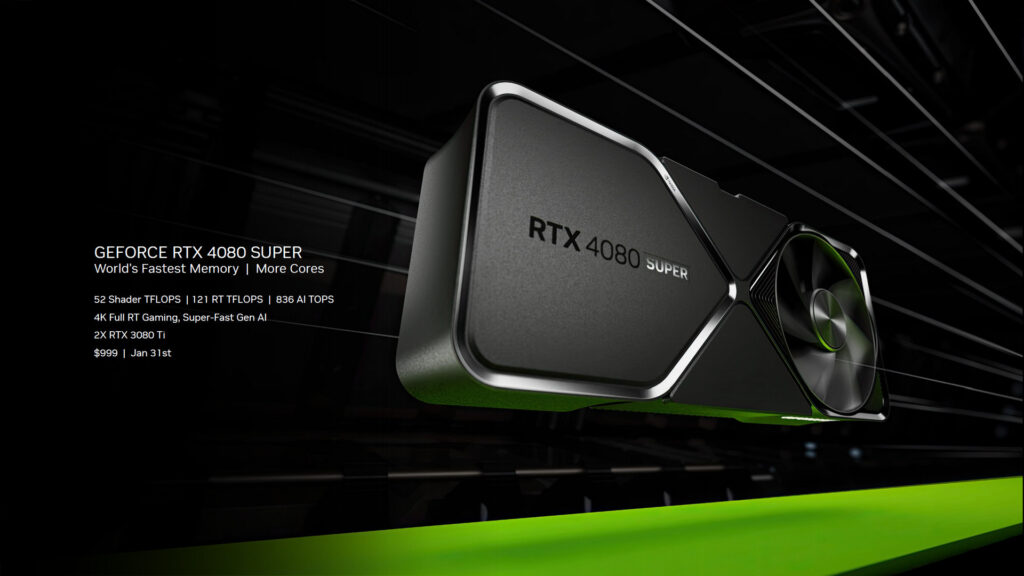
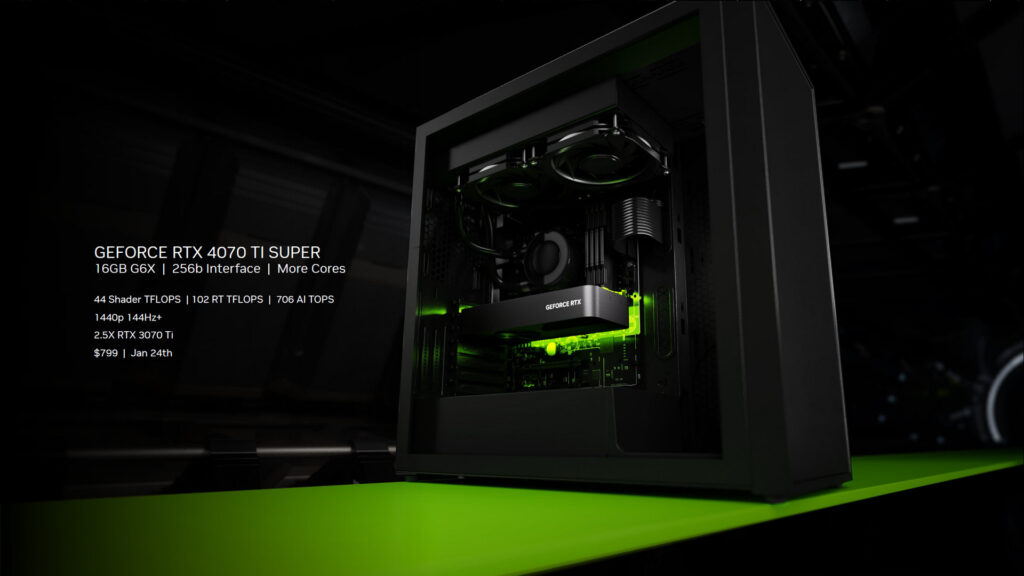
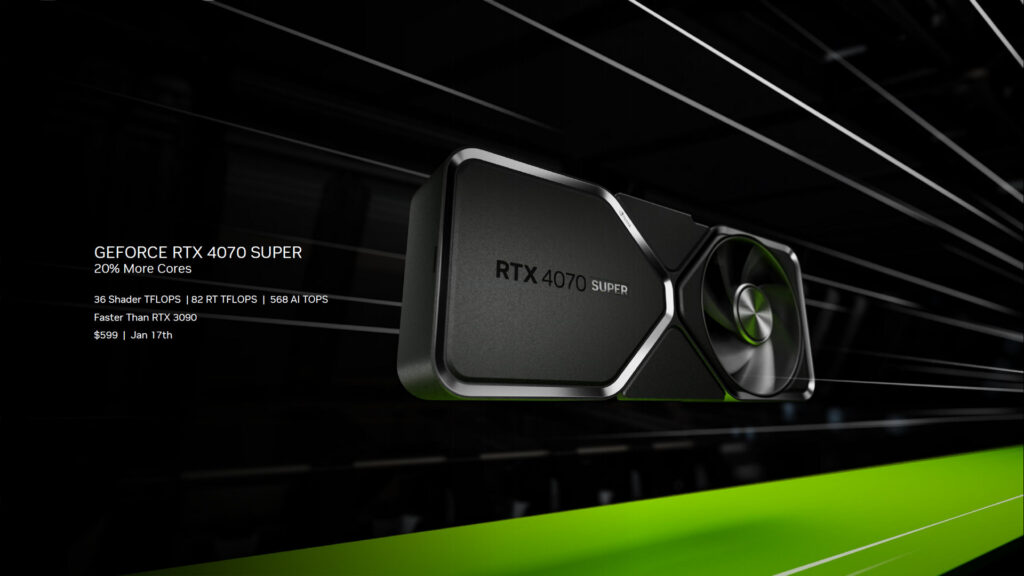
The NVIDIA RTX 4080 Super has been upgraded with 80 SM units, 10,240 CUDA cores, 320 Tensor cores, 80 RT cores, and a slightly higher boost clock of 2550 MHz, while maintaining 16GB of GDDR6X memory and a 320W TGP. This results in a core number increase of about 5% and offers more value for money due to the higher clock speed and reduced price.
The RTX 4070 Ti Super features 66 SM units, 8,448 CUDA cores, 264 Tensor cores, and 66 RT cores, with a constant clock speed and power consumption. It also has increased TU and ROP units, along with 16GB GDDR6X memory, making it a potential highlight of this Super update with a 10% increase in core numbers.
The RTX 4070 Super includes 56 SM units, 7,168 CUDA cores, 224 Tensor cores, and 56 RT cores. It retains the same GPU clock and memory specifications but slightly increases the TGP to 220W. This model has a 22% increase in core numbers, delivering a 10% performance boost in ray tracing and DLSS accelerated games compared to the RTX 4070, yet 10% less than the RTX 4070 Ti, showcasing NVIDIA’s precision in balancing performance and cost.
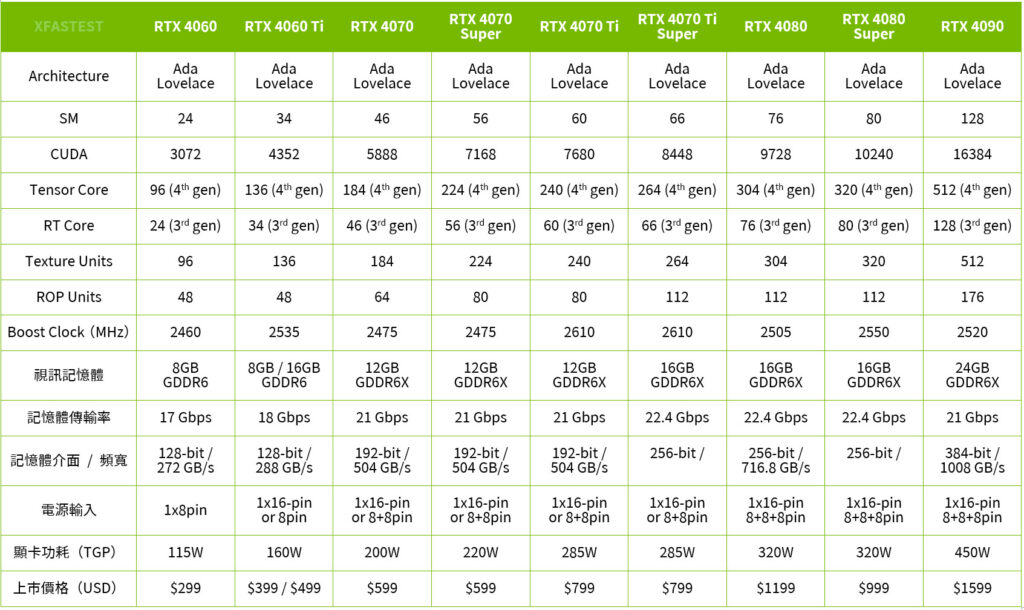
The shows the specifications for NVIDIA’s RTX 40 series and the Super variants. It details the architecture, which is Ada Lovelace across all models, and provides specifics such as the number of SM units, CUDA cores, Tensor and RT cores, as well as texture and ROP units. It also includes information on the boost clock speeds, memory type and size, memory speed, memory bandwidth, power connectors, typical graphics power (TGP), and the U.S. pricing for each model. The Super series appears to offer an increase in CUDA core count and memory speeds, providing improved performance at similar or adjusted price points compared to the non-Super models.
NVIDIA plans to phase out the original RTX 4080 and RTX 4070 Ti models, replacing them with the newer Super variants. In the RTX 40 series lineup, the RTX 4090 and RTX 4080 Super are positioned as the top-performing 4K gaming cards. For 1440p gaming, the RTX 4070 Ti Super, RTX 4070 Super, and RTX 4070 are available. Entry-level options include the RTX 4060 Ti and RTX 4060, covering a wide range of gaming needs, including next-generation ray tracing and AI acceleration.
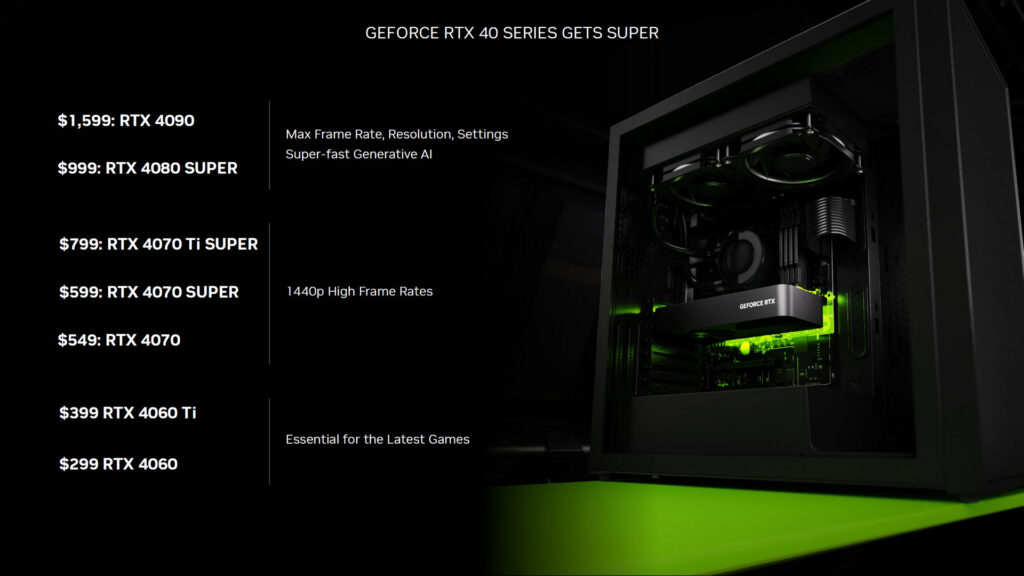
The image displays NVIDIA’s new RTX 40 Super series lineup, illustrating their performance tier and pricing. The RTX 4090 sits at the top, priced at $1,599, and labeled for maximum frame rate, resolution, and settings. The RTX 4080 Super is highlighted for super-fast generative AI capabilities at $999. The RTX 4070 Ti Super and RTX 4070 Super are noted for 1440p high frame rates at $799 and $599, respectively. The RTX 4070 is offered at $549. For essential performance in the latest games, the RTX 4060 Ti is priced at $399, and the RTX 4060 is the most accessible at $299. The image showcases the GPUs within a computer case, emphasizing their role in enhancing gaming experiences.
NVIDIA GeForce RTX 4070 Super & 4080 Super: Exclusive Look at the Founder’s Editions
The NVIDIA GeForce RTX 4070 Super will have a Founders Edition available, similar in design to the RTX 4070 Founders Edition, with the distinction that the Super variant features an all-black design, giving it a unique, understated appearance. The RTX 4070 Super Founders Edition is designed to be compact and case-friendly, featuring a 24cm length and a 2-slot width. It’s constructed with a black anodized aluminum X-Frame chassis filled with heat dissipation fins and includes a vapor chamber for cooling the GPU and VRAM, along with heat pipes to guide waste heat to the fins. The cooling system consists of two 9cm fans, with the rear fan expelling heat out the back of the card and the front fan drawing in air from the front of the case, aiding in optimal airflow and cooling inside the case.
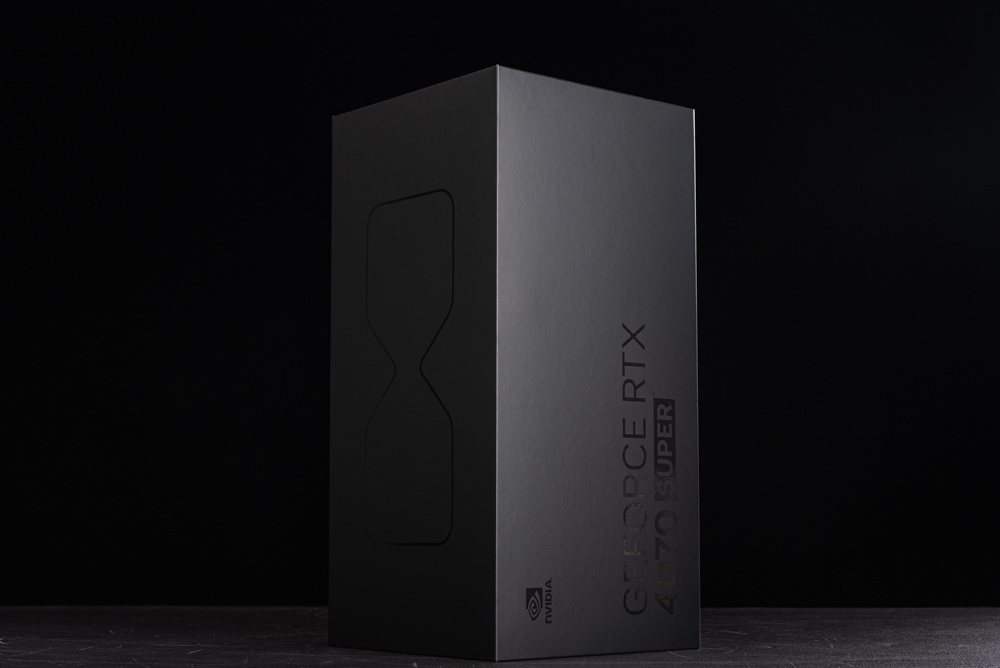
The packaging for the NVIDIA GeForce RTX 4070 Super Founders Edition reflects the all-black design of the graphics card itself, emphasizing a sleek and understated aesthetic. The box is predominantly black with a subtle silhouette of the card’s shape, along with the product name embossed in a discreet gray font, aligning with the overall minimalist and premium presentation of the product.
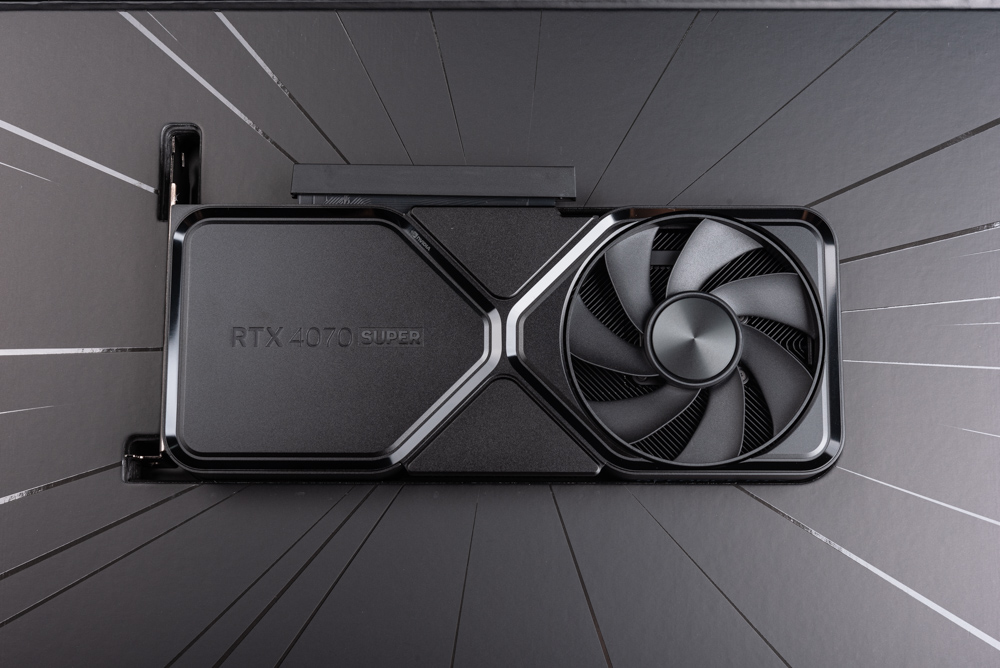
The RTX 4070 Super boasts an elegant black design with a dual-tone finish, featuring a reflective mirror-like surface on its aluminum frame and a matte black metal covering. This design emphasizes a sleek and modern aesthetic, aligning with the premium look typical of high-performance hardware. The graphics card’s appearance combines a professional and stylish design, likely to appeal to users who appreciate a sophisticated look in their gaming setup or workstation.
The NVIDIA RTX 4070 Super Founders Edition is designed with a high-quality, black anodized aluminum X-frame that features a reflective mirror finish for a premium feel. The card’s surface is a matte black metal shell which adds to the sophisticated aesthetic. The “RTX 4070” marking is etched in, providing a subtle depth, while the “SUPER” inscription stands out with a raised metal cut, contributing to the card’s understated elegance. The other side of the card is meticulously designed with an array of cooling fins to ensure efficient heat dissipation.
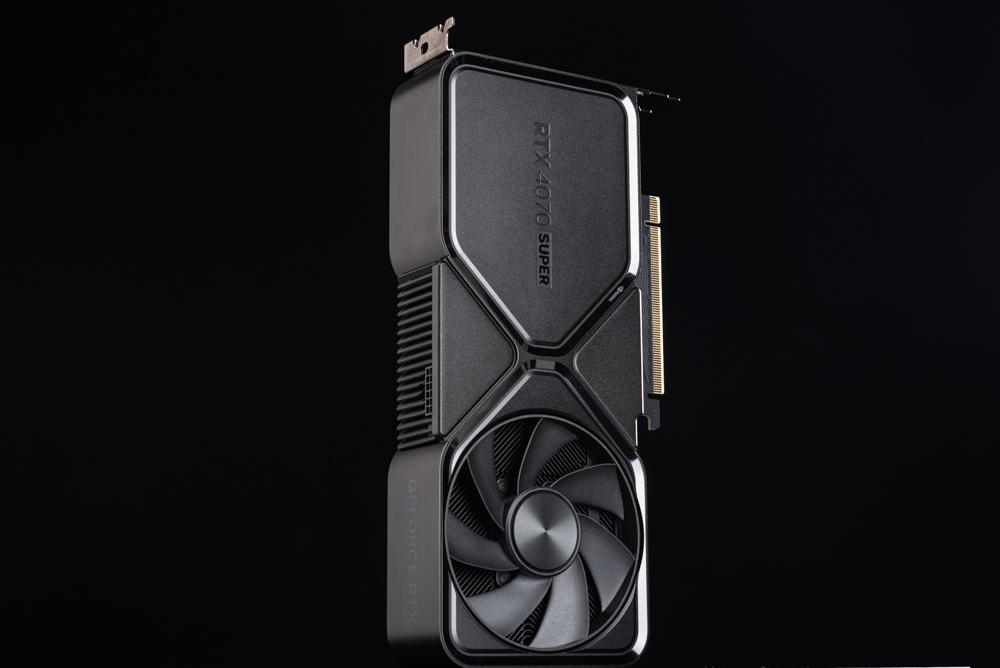
Depicts the NVIDIA GeForce RTX 4070 Super Founders Edition graphics card with its distinctive all-black design. The card features a sleek, anodized aluminum frame with a mirrored finish, providing a high-quality, reflective effect. The surface has a matte black finish, and the model’s name is prominently displayed, with the “RTX 4070” inscription recessed and the “SUPER” in a raised cut, adding to the refined look. The design emphasizes a premium and modern aesthetic suitable for high-performance PC builds.
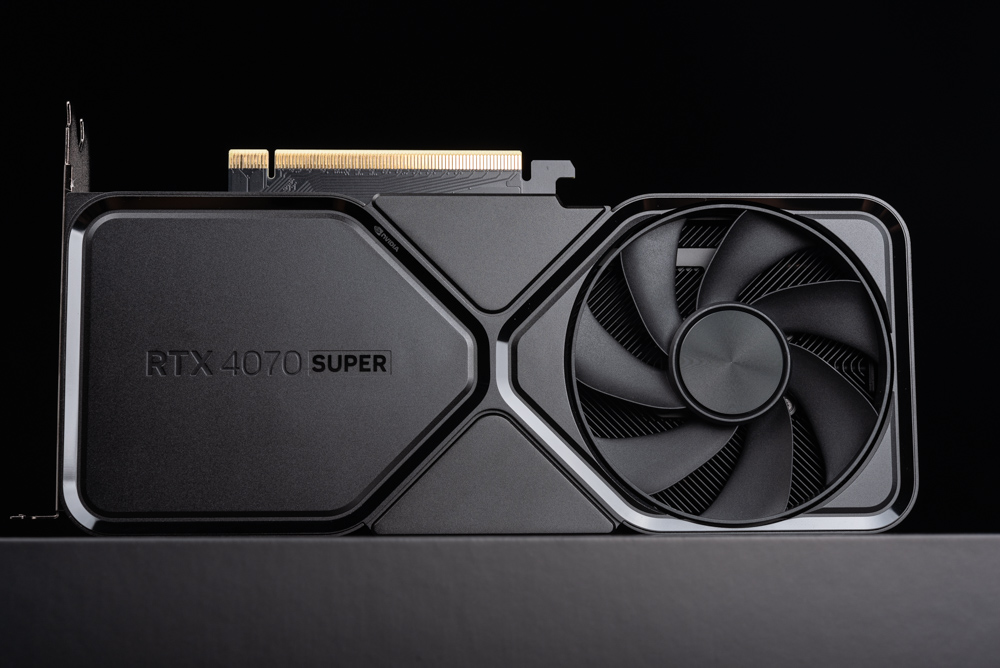
The NVIDIA RTX 4070 Super Founders Edition graphics card is showcased in the image, highlighting its sophisticated design. It features a black anodized aluminum X-frame and a matte black metal surface, combining elegance with functionality. The card’s branding is subtly integrated into the design, with “RTX 4070 SUPER” engraved into the surface, enhancing its sleek and modern aesthetic. This design ensures that the card not only performs well but also looks impressive in any PC build.
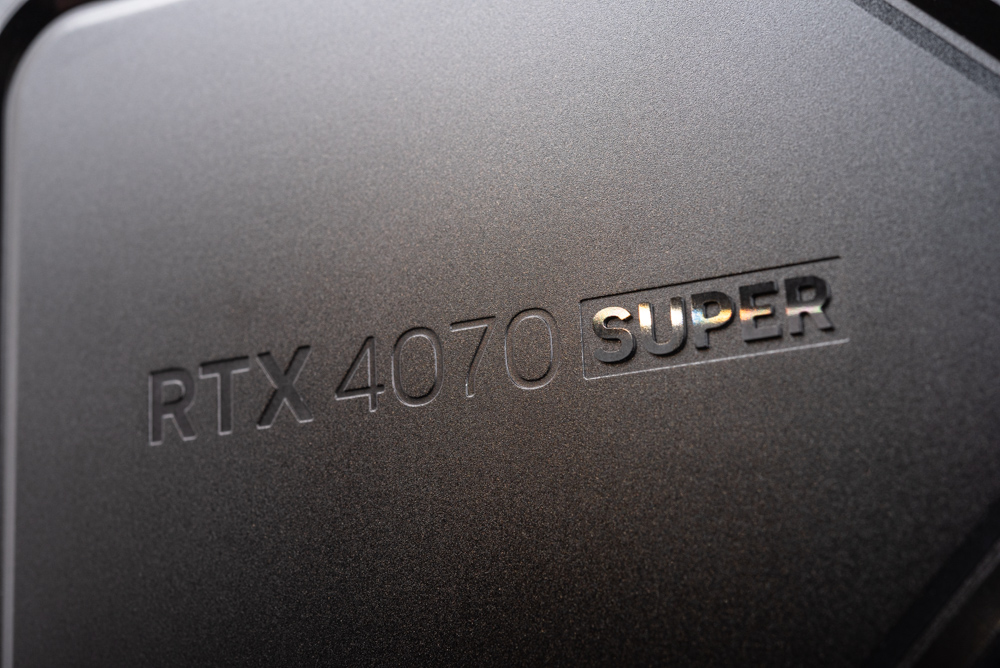
The close-up image highlights the branding on the NVIDIA RTX 4070 SUPER, with the model name prominently embossed on the card’s matte black surface. The “RTX 4070” part is recessed into the metal, while the “SUPER” appears in a raised, reflective finish, creating a striking visual contrast. This subtle yet sophisticated design detail emphasizes NVIDIA’s attention to aesthetics as well as performance in their Founders Edition cards.
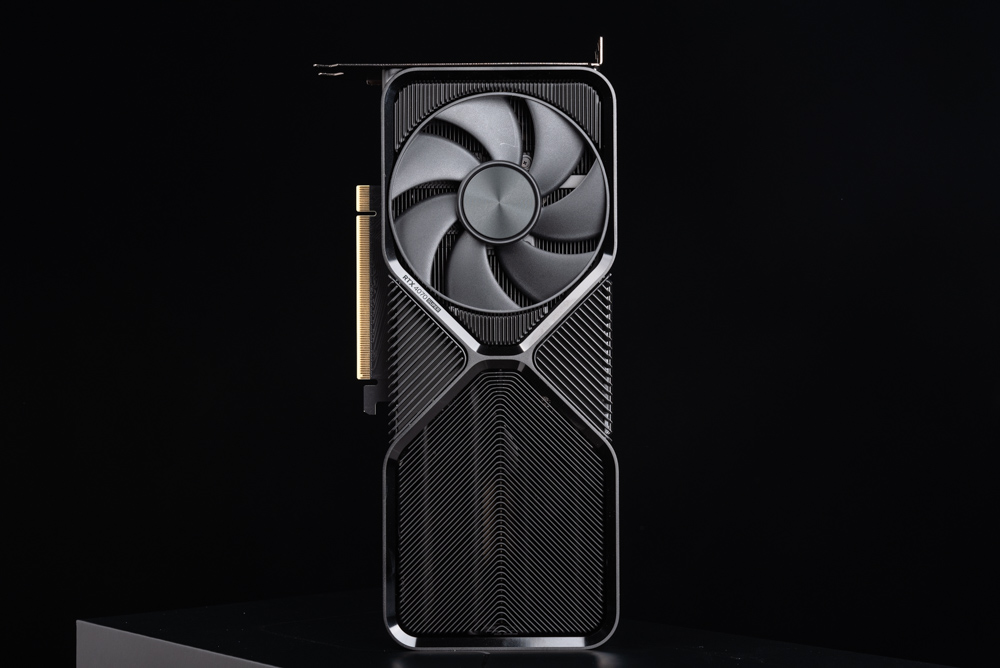
The detailed heat sink fin array of the NVIDIA RTX 4070 SUPER graphics card. The intricate design of the fins is engineered for optimal thermal performance, ensuring efficient heat dissipation during intensive computing tasks. The card’s overall design, featuring a single fan and angular geometrical patterns, highlights NVIDIA’s commitment to combining form with function in their Founders Edition series.
The NVIDIA RTX 4070 SUPER graphics card incorporates a modern PCIe 12+4 Pin power connector, also known as 12VHPWR, situated at the side of the card for power supply. The card comes with an adapter cable that converts the new PCIe 12+4 Pin connector to two traditional PCIe 8 Pin connectors, ensuring compatibility with existing power supplies. This new design of the PCIe connector positions the metal pins closer to the edge of the terminal for a secure connection, ensuring that the pins fully contact the corresponding slots on the motherboard once the connector is fully inserted.
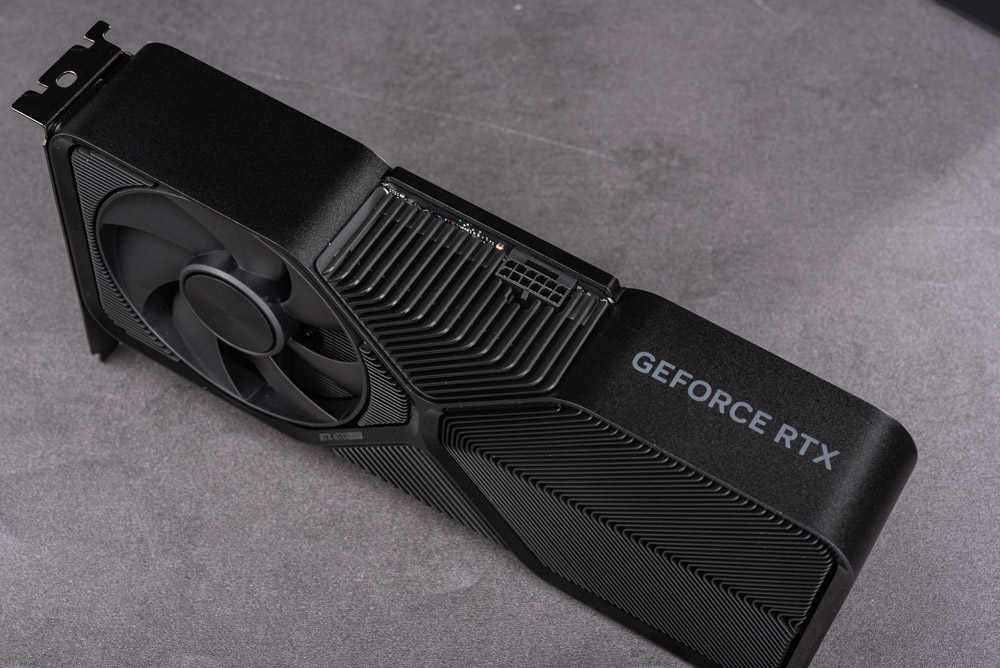
The side view of the NVIDIA GeForce RTX graphics card, featuring the PCIe 12+4 Pin (12VHPWR) power connector. This modern power input design is key for supplying the necessary power to support the card’s performance demands. The connector is designed to ensure a secure connection and stable power delivery, reflecting the card’s compatibility with new-generation power supply standards. The card’s sleek black casing with the “GEFORCE RTX” branding complements its high-performance capabilities with a visually striking design.
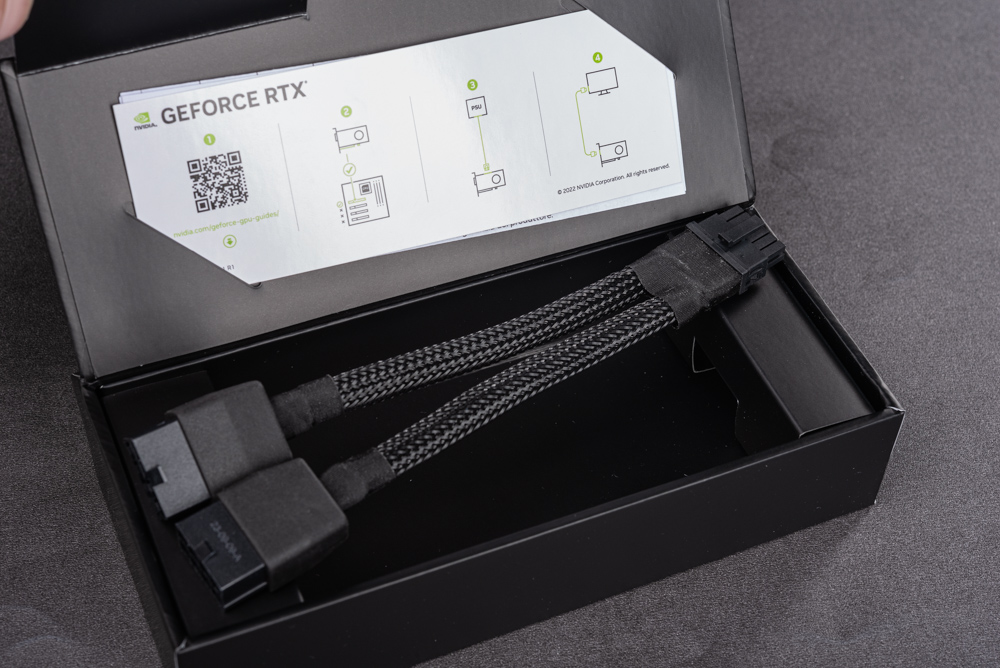
The inside of a product box for an NVIDIA GeForce RTX graphics card, showcasing the included PCIe 12+4 Pin power adapter cable. This cable is designed to convert the 12+4 Pin connection to two 8 Pin connectors, allowing compatibility with power supplies that do not have a native 12+4 Pin cable. Accompanying the adapter is a quick setup guide with instructions and a QR code that is likely an online manual or additional resources for installation.
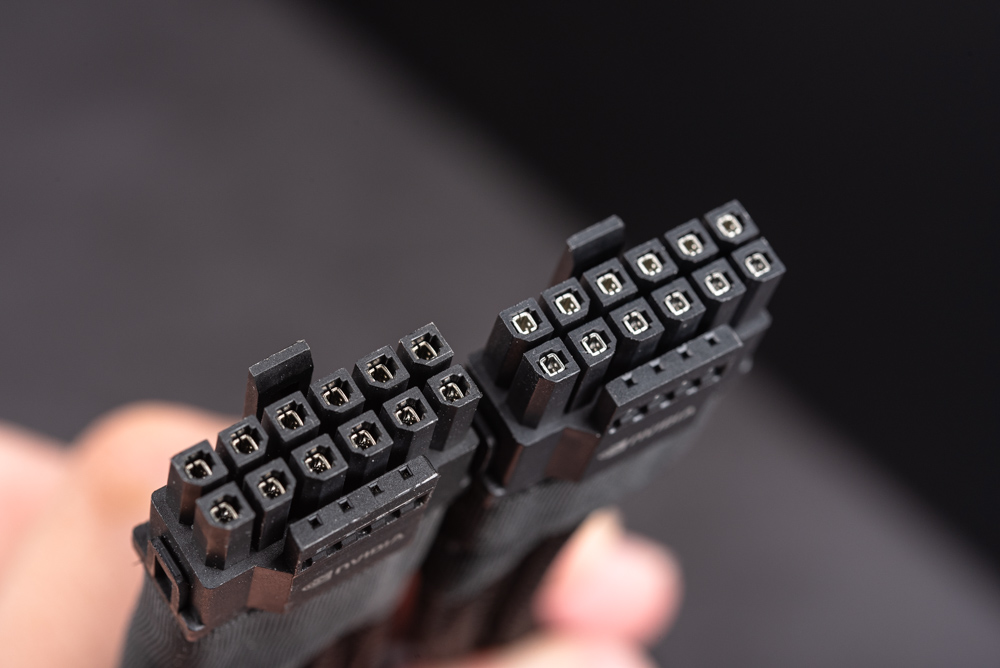
A close-up view of the new power cable adaptors, with the right side of the image presenting the latest design. Here, the metal pins are positioned closer to the edge of the connector, which is an improvement intended to ensure a more secure and complete connection to the power supply unit’s terminals. This adjustment is a detail that reflects the meticulous design approach to ensure reliable power delivery to high-performance graphics cards.
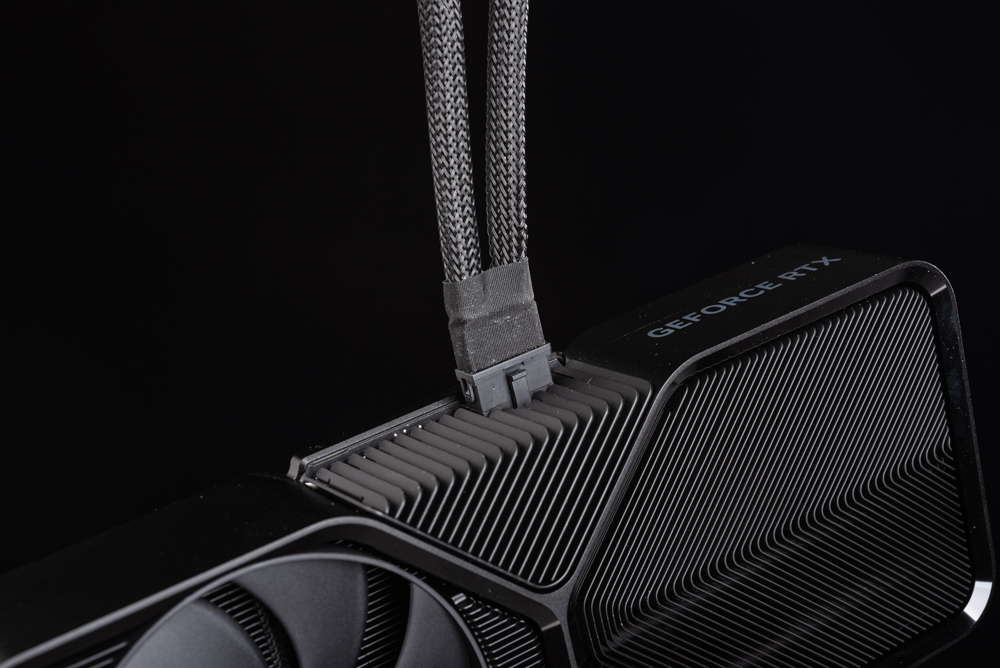
The power connector of a graphics card is securely plugged into the card’s power socket, illustrating a stable and reliable connection. This is essential for ensuring the graphics card receives the proper power supply for optimal performance. The design of the cable and connector typically aims to provide a snug fit to prevent accidental disconnections or power interruptions during use.
The NVIDIA graphics card offers a robust display output configuration, providing one HDMI 2.1a port that supports Variable Refresh Rate (VRR), along with 4K at 120Hz or 8K at 60Hz with High Dynamic Range (HDR). There are also three DisplayPort 1.4a outputs with Display Stream Compression (DSC), supporting up to 12-bit color for 4K at 240Hz HDR or 8K at 60Hz HDR. The card can manage up to four screens simultaneously, allowing for an extensive multi-monitor setup.
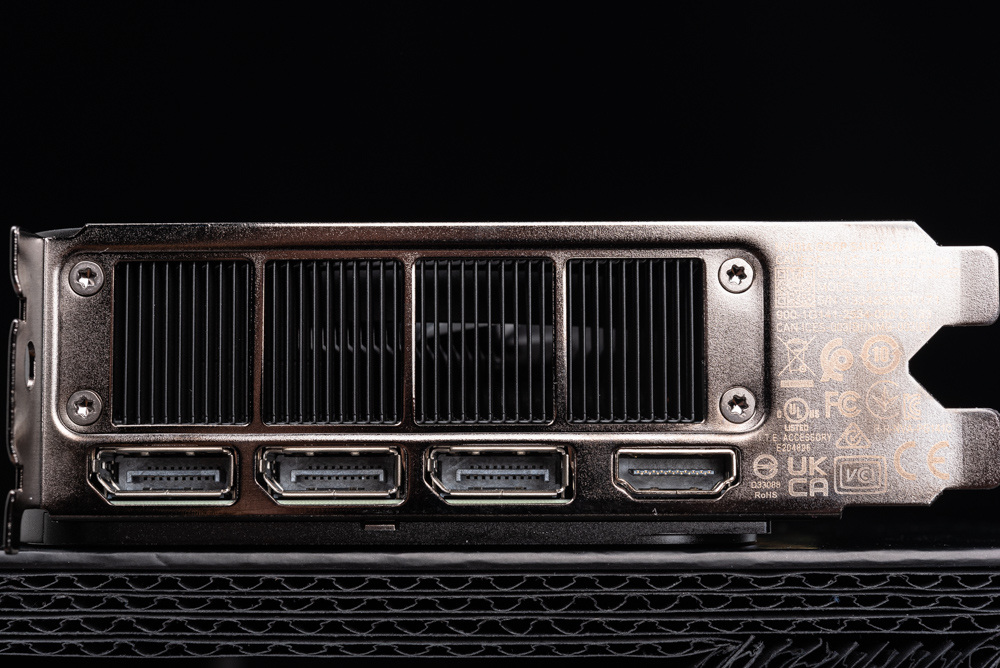
The display output section of the NVIDIA GeForce RTX series graphics card. It shows one HDMI port and three DisplayPort connectors, which support high-resolution and high-refresh-rate outputs, including HDMI 2.1a and DisplayPort 1.4a standards. The vented bracket next to the ports allows hot air to be expelled from the card, helping with the cooling process. The design is typical of high-end NVIDIA cards, which provide multiple options for monitor connectivity and support for advanced features like HDR and VRR.
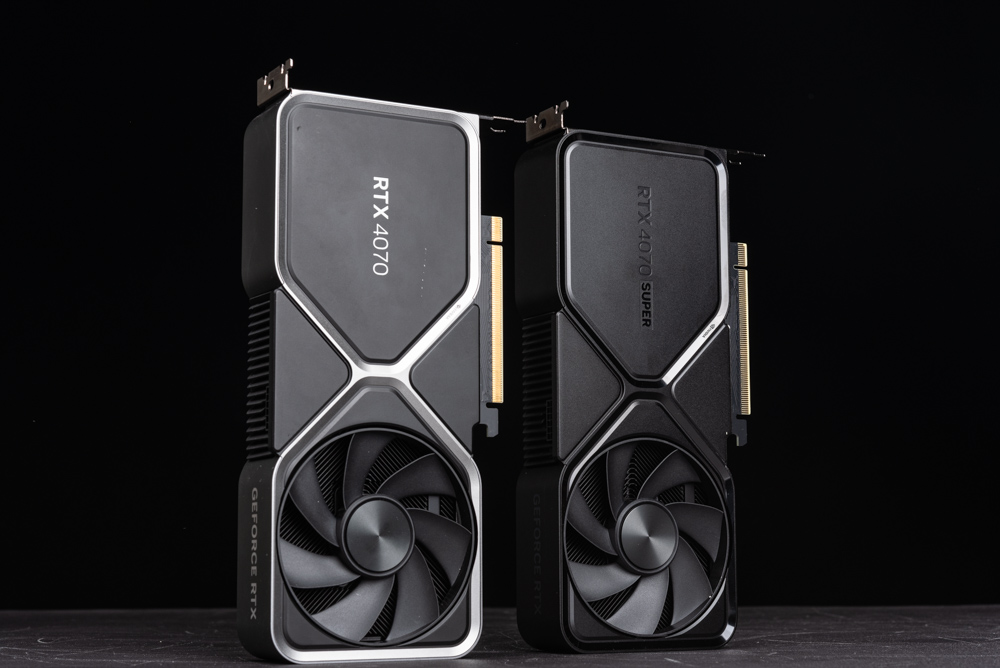
The two side-by-side NVIDIA graphics cards are the RTX 4070 and the RTX 4070 Super Founders Edition. Both cards share a similar aesthetic design, with the Super variant typically featuring boosted performance specs compared to the non-Super version. These models are part of NVIDIA’s RTX 40 series, which is known for advanced ray tracing capabilities and AI-driven performance enhancements for gaming and creative work.
Comprehensive Test Results: NVIDIA RTX 4070 Super in Creative and Gaming Scenarios
The test includes performance evaluations using DaVinci Resolve 18 and Blender for creative tasks, and gaming tests at 1440p and 2160p resolutions with maximum settings to assess the capabilities in eSports, AAA titles, ray tracing performance, and DLSS 3 technology. The comparison includes the RTX 4070, RTX 4070 Ti, and RX 7800 XT, providing a comprehensive data set for consumers. The test rig features an Intel Core i9-14900K processor, ASUS ROG MAXIMUS Z790 DARK HERO motherboard, 64GB of Crucial DDR5 memory, and more, with Windows 11 Pro and the latest drivers. The RTX 4070 Super, built on a 5nm process, has 7168 CUDA cores and 12GB GDDR6 memory, with a base clock of 1980 MHz and a boost of 2475 MHz.
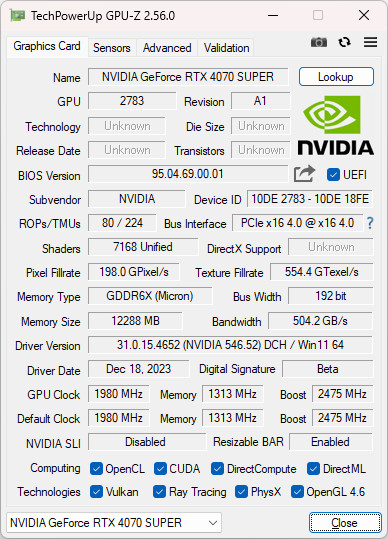
The screenshot provided is from the GPU-Z application, showing the specifications for the NVIDIA GeForce RTX 4070 SUPER graphics card. It lists details like the GPU’s name, device ID, number of ROPs/TMUs, shaders, clock speeds, memory type and size, bus width, and supporting technologies such as DirectX, Vulkan, CUDA, and others. The key specifications highlighted include 7168 shaders, a memory size of 12GB GDDR6X, and a boost clock of 2475 MHz. This tool is commonly used to verify and check detailed information about the graphics hardware in a system.
The RTX 4070 Super’s performance in Adobe Photoshop and Lightroom Classic was assessed using the UL Procyon Photo Editing Benchmark tool. It achieved a score of 9130, with 9688 in Image Retouching and 8606 in Batch Processing. These results indicate that the RTX 4070 Super, along with the RTX 4070 Ti and RTX 4070, offers sufficient power for general image editing tasks, demonstrating that the latest generation GPUs are well-equipped to handle such workloads efficiently.
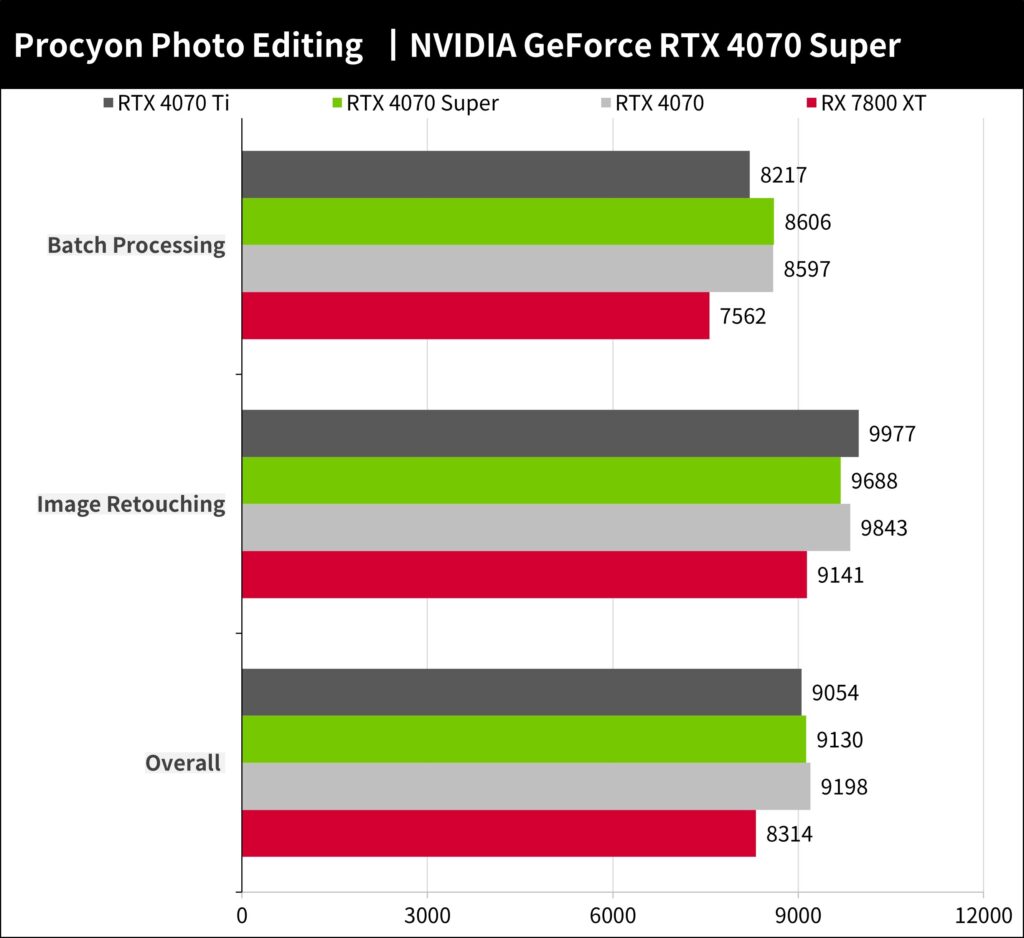
The provided benchmark graph compares the performance scores from the UL Procyon Photo Editing Benchmark for different graphics cards, with higher scores indicating better performance. The RTX 4070 Ti, RTX 4070 Super, RTX 4070, and RX 7800 XT are evaluated in terms of Overall, Image Retouching, and Batch Processing performance. The RTX 4070 Super shows competitive results, particularly in Image Retouching, suggesting its strong performance in graphics-intensive photo editing tasks.
In the PugetBench for DaVinci Resolve test, which assesses video editing performance for 4K and 8K media, the RTX 4070 Super scored a total of 3077 points. It scored 211 points for 4K Media, 140 points for GPU Effects, and 572 points for Fusion Effects. It’s worth noting that in this particular benchmark, the RX 7800 XT outperformed the RTX 4070 Super. These results are instrumental in gauging a computer’s performance in video production tasks using DaVinci Resolve, especially when leveraging GPU-intensive effects and tasks.
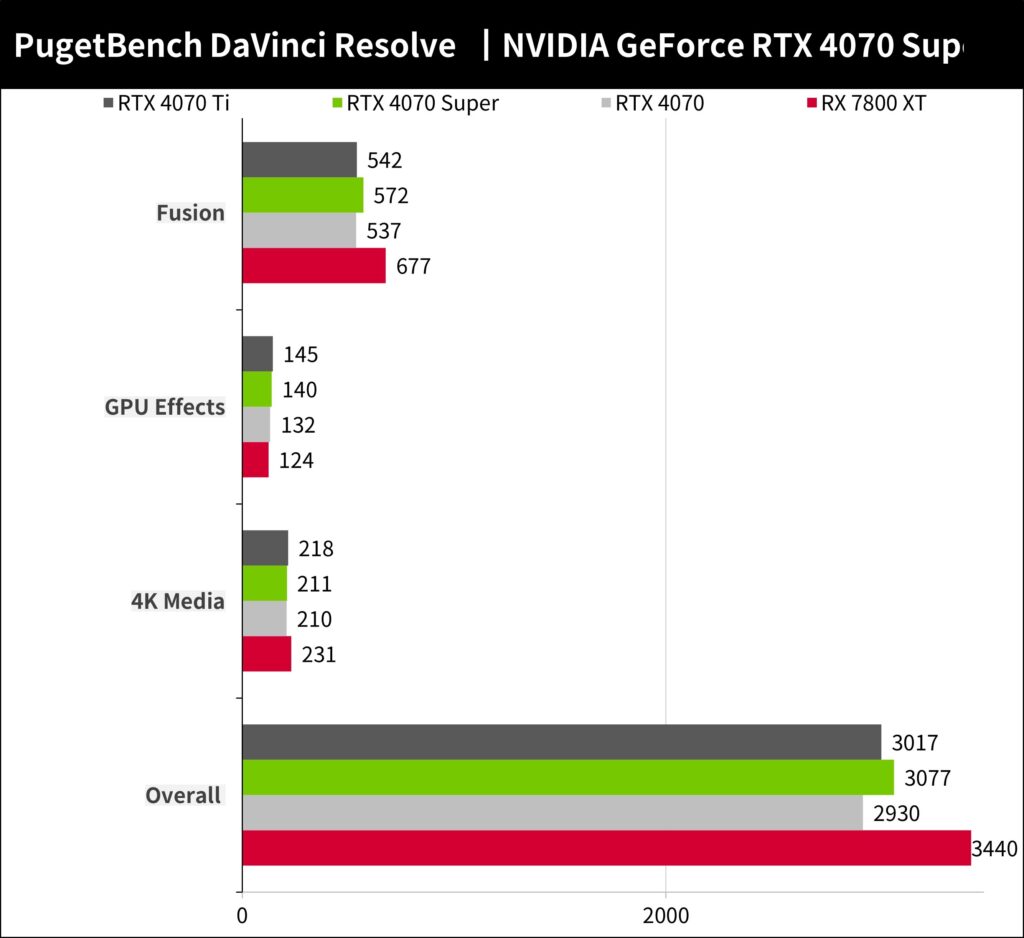
The chart from the PugetBench for DaVinci Resolve benchmark shows the performance scores of various graphics cards, including the RTX 4070 Ti, RTX 4070 Super, RTX 4070, and RX 7800 XT. The RTX 4070 Super shows a solid performance across the board with particularly strong results in the Fusion category. Overall, it demonstrates that the RTX 4070 Super is a capable card for video editing tasks in DaVinci Resolve, although the RX 7800 XT has the highest score overall in this benchmark.
The RTX 4070 Super has shown commendable performance in the V-Ray Benchmark, which tests ray tracing rendering capabilities on both CPUs and GPUs. It scored 2924 points for RTX computations and 2178 points for CUDA computations. These results represent an average performance improvement of 18% over the RTX 4070, and it’s just 2% behind the RTX 4070 Ti, indicating that the RTX 4070 Super offers a good balance of performance and value.
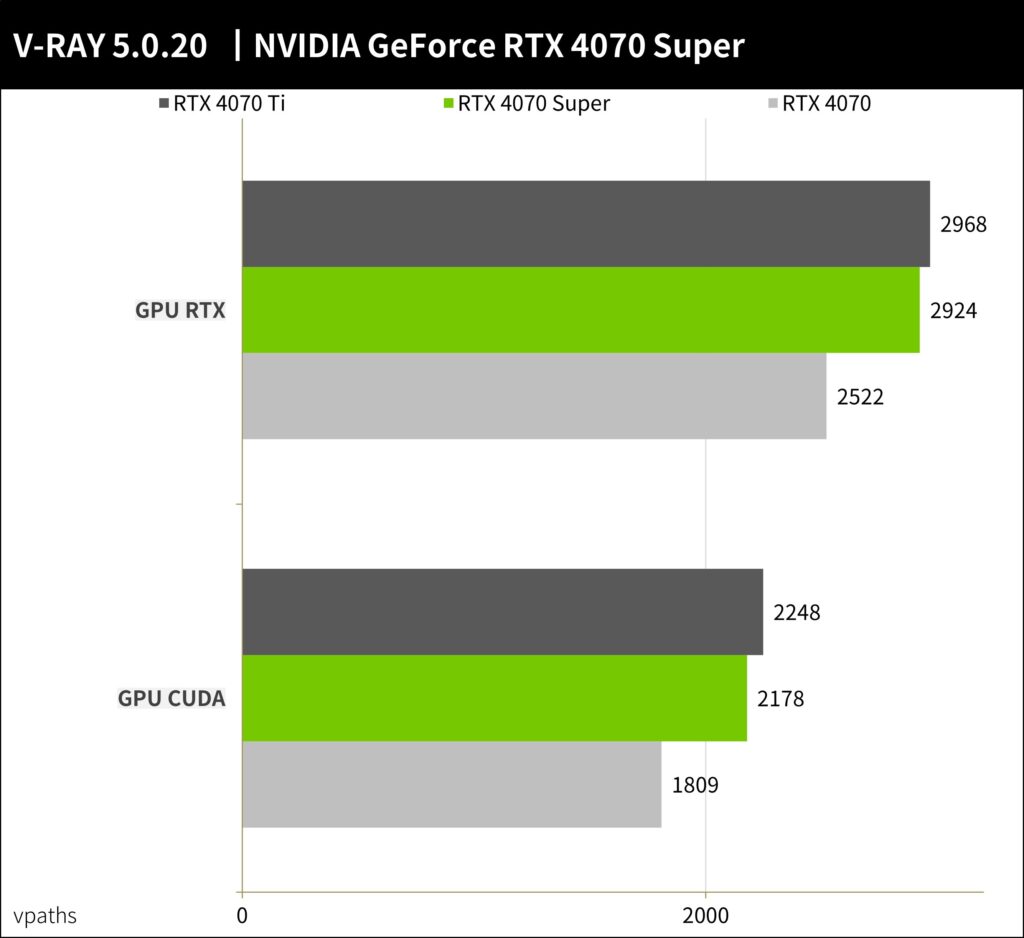
The chart displays scores from the V-Ray Benchmark, where higher scores indicate better performance. The RTX 4070 Super’s scores are very close to those of the RTX 4070 Ti in both RTX and CUDA tests, showing that it provides near-top-tier performance, particularly for a card that sits just below the 4070 Ti in the product lineup. The RTX 4070 Super shows a significant improvement over the RTX 4070, reinforcing its position as a strong contender in GPU rendering tasks.
The RTX 4070 Super demonstrates significant rendering performance in Blender, a comprehensive open-source 3D creation suite. With the RTX 4070 Super, users can expect an approximate 17% performance increase over the RTX 4070, and it performs only about 3% lower than the RTX 4070 Ti. This suggests that the core upgrades in the RTX 4070 Super have a substantial impact on rendering tasks, making it a powerful option for 3D artists and professionals using Blender for their workflows.
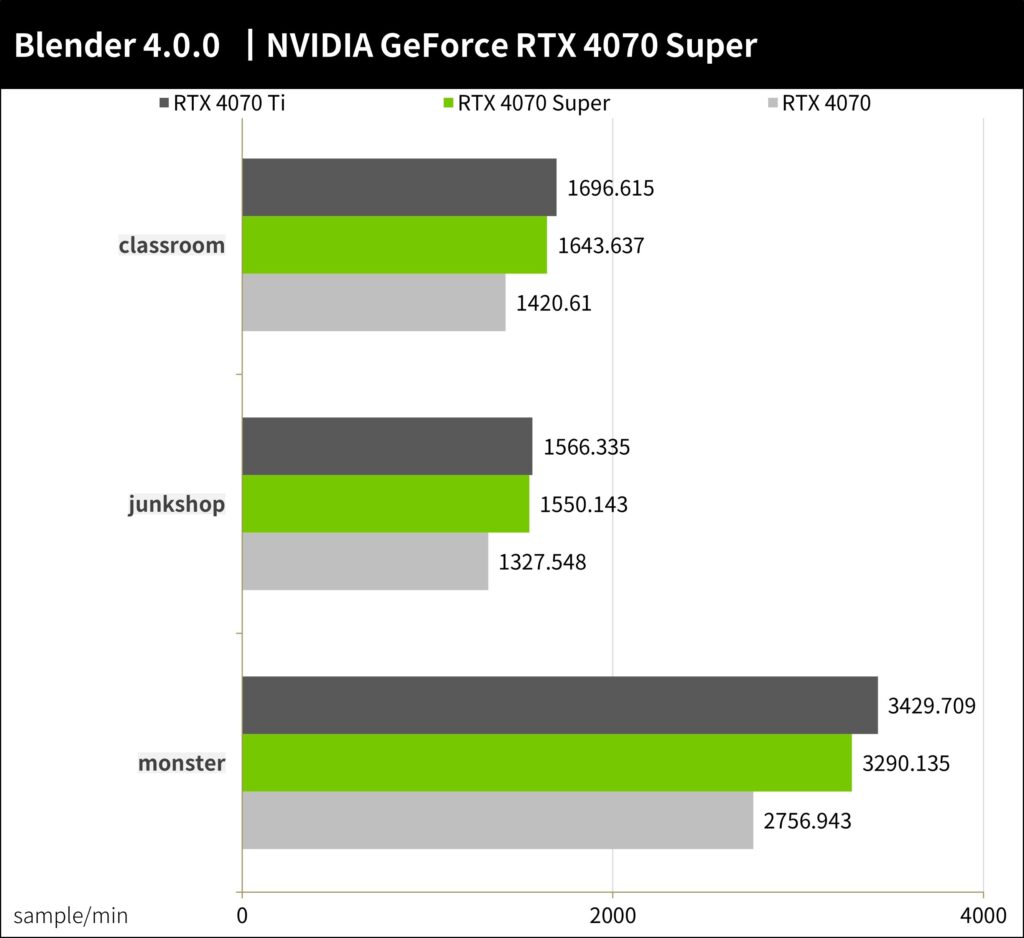
The chart from the Blender 4.0.0 benchmark shows scores for various NVIDIA graphics cards, specifically the RTX 4070 Ti, RTX 4070 Super, and RTX 4070, across different rendering tests like ‘classroom,’ ‘junkshop,’ and ‘monster.’ Higher scores indicate better performance, and from the data, it’s visible that the RTX 4070 Super performs very well, closely trailing the RTX 4070 Ti and significantly outperforming the RTX 4070, especially in the ‘monster’ test. This suggests the RTX 4070 Super is a robust choice for 3D rendering tasks.
The RTX 4070 Super has achieved a score of 19,092 in the CINEBENCH 2024 benchmark, which uses the Redshift rendering engine from Cinema 4D for comprehensive GPU and CPU testing. This score places the RTX 4070 Super’s performance on par with the RTX 4070 Ti and demonstrates a significant 23% improvement over the RTX 4070, indicating its strong rendering capabilities.
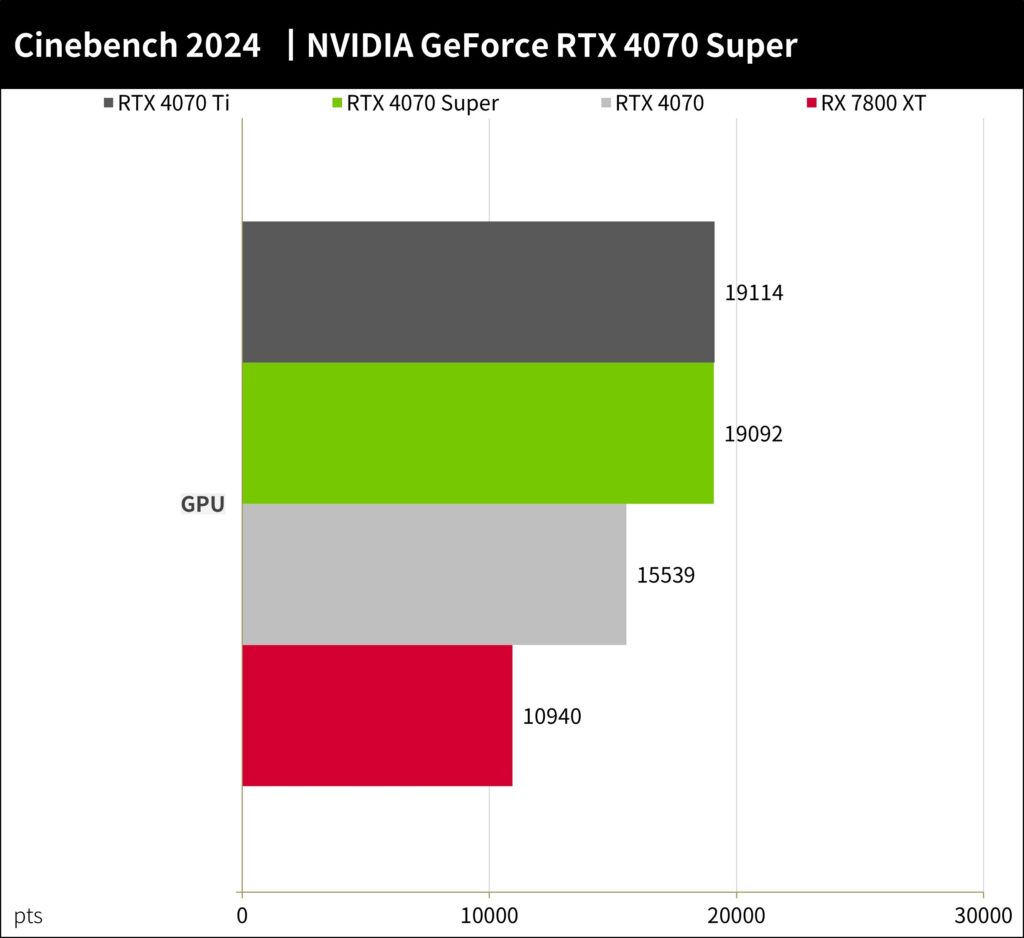
The CINEBENCH 2024 benchmark chart shows the RTX 4070 Super almost matching the RTX 4070 Ti and significantly outperforming the RTX 4070 and RX 7800 XT in GPU-related tasks. The scores indicate that the RTX 4070 Super offers excellent performance, closely aligning with its higher-tier counterpart, making it a strong contender for GPU-intensive workflows.
Boosting AI Image Generation: Stable Diffusion on NVIDIA RTX 4070 Super with TensorRT
Stable Diffusion, a popular AI deep learning model for generating images from text, gains enhanced GPU acceleration performance when manually installed with the standard version released by Automatic1111 and further optimized with TensorRT. This combination of software and hardware optimizations ensures that Stable Diffusion can operate at its highest efficiency, leveraging the advanced capabilities of the GPU to speed up image generation.
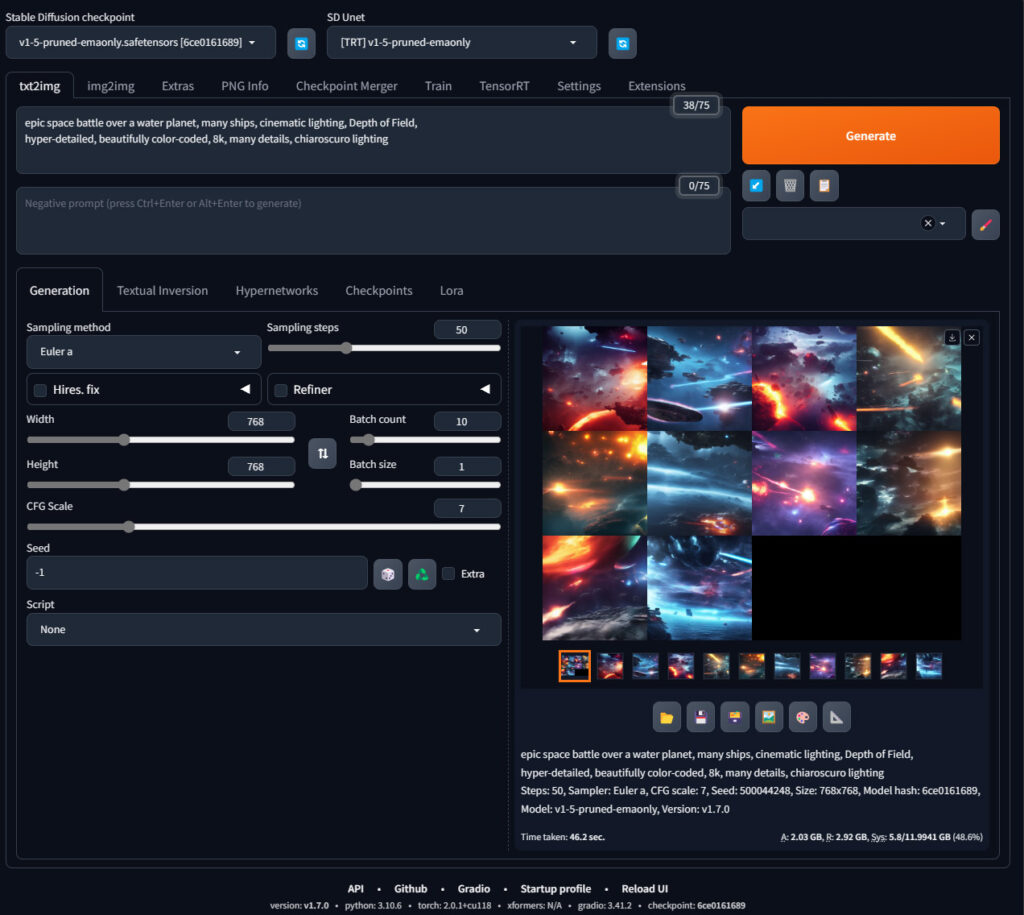
The WebUI of Stable Diffusion is a user interface designed for interacting with the Stable Diffusion text-to-image model. The interface shows the settings for generating an image based on the input prompt, which describes an epic space battle scene. The model, sampling method, steps, resolution, and other parameters can be adjusted according to the user’s preference for image generation. The output section displays a series of images generated by the model, which visually interprets the text prompt into complex scenes with ships and dramatic lighting.
The RTX 4070 Super, optimized with TensorRT, achieved a significant improvement in image generation speed during testing with the Stable Diffusion model. It managed to generate 12.99 images per minute, which is a substantial 162% increase compared to the standard performance of the Automatic1111 version, which produced only 4.96 images per minute. When compared to the RTX 4070, the RTX 4070 Super showed a 14% performance gain, and it was only 10% slower than the RTX 4070 Ti.
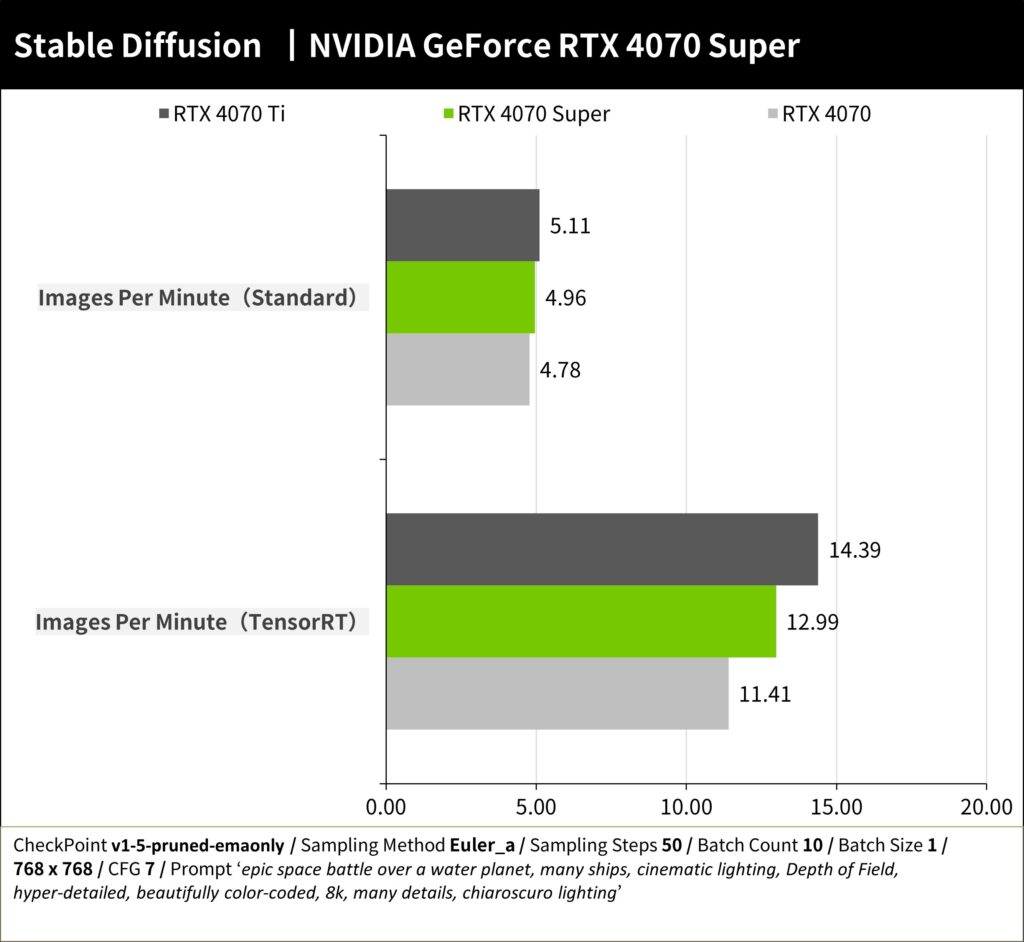
The graph illustrates the image generation performance of various NVIDIA GPUs using Stable Diffusion with both standard settings and TensorRT optimization. The RTX 4070 Super significantly outperforms the standard model when using TensorRT, showcasing a substantial increase in images generated per minute. This emphasizes the RTX 4070 Super’s capability in AI-driven tasks when optimized with TensorRT, offering a notable improvement over standard configurations.
NVIDIA RTX 4070 Super Dominates in 3DMark Tests: Fire Strike, Time Spy, and Ray Tracing Performance
The RTX 4070 Super’s performance on the 3DMark Fire Strike benchmarks, which measure DirectX 11 API capabilities at different resolutions, indicates a solid performance. The card scores highly across 1080p, 1440p Extreme, and 2160p Ultra settings, showing an average of 17% improvement over the RTX 4070 and performing just 7% below the RTX 4070 Ti. This positions the RTX 4070 Super as a strong contender for high-end gaming performance at various resolutions.
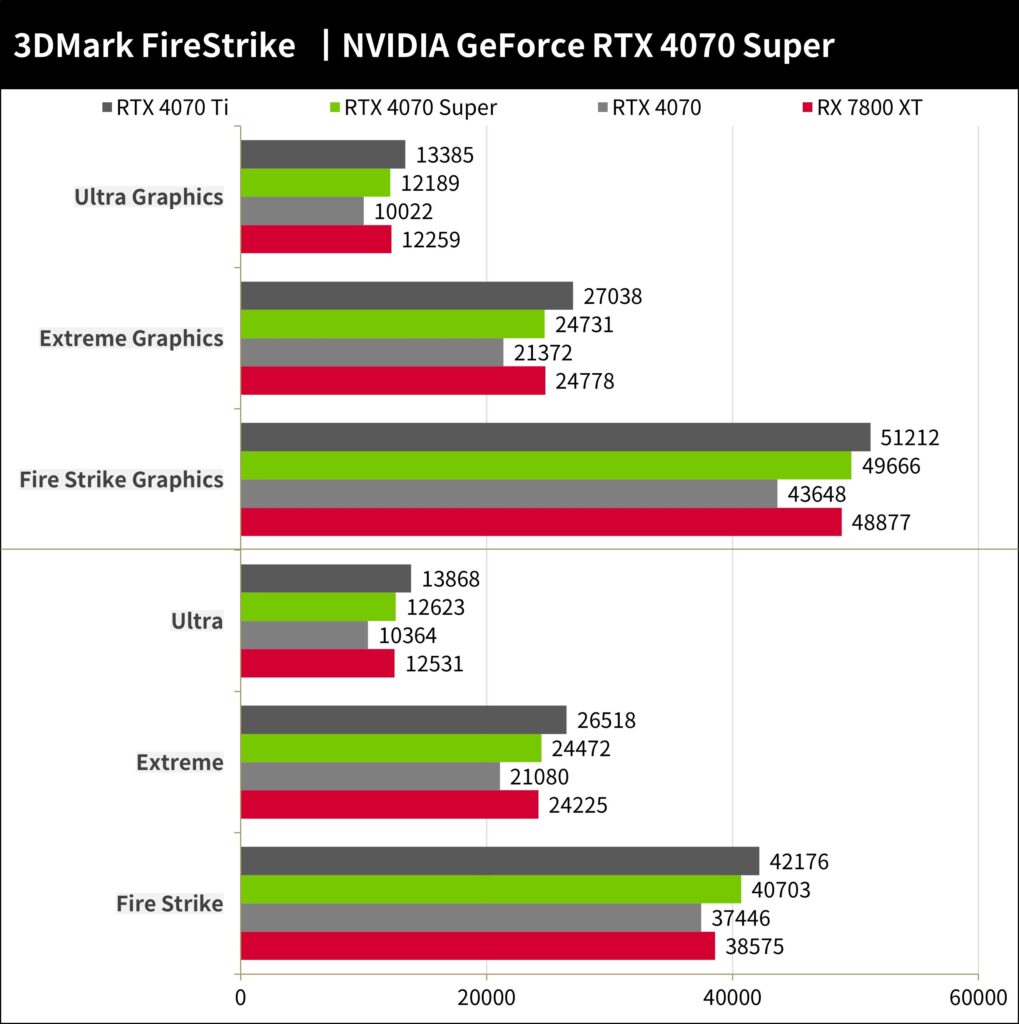
The chart from the 3DMark Fire Strike benchmark compares the RTX 4070 Ti, RTX 4070 Super, RTX 4070, and RX 7800 XT across different graphics performance tests. The RTX 4070 Super’s scores are robust, showcasing that it offers high performance close to the RTX 4070 Ti and significantly outperforms the RTX 4070. The RX 7800 XT also shows strong performance, particularly in the Ultra test. Overall, the RTX 4070 Super provides a strong balance of power and efficiency.
The 3DMark Time Spy benchmark, which utilizes the DirectX 12 API, is designed to test the performance of GPUs at the AAA gaming level at resolutions of 1440p and 2160p Extreme. The RTX 4070 Super’s performance is commendable, showing a 17% improvement over the RTX 4070, while being about 10% behind the RTX 4070 Ti. This suggests that the RTX 4070 Super is a strong performer for contemporary gaming demands at high resolutions.
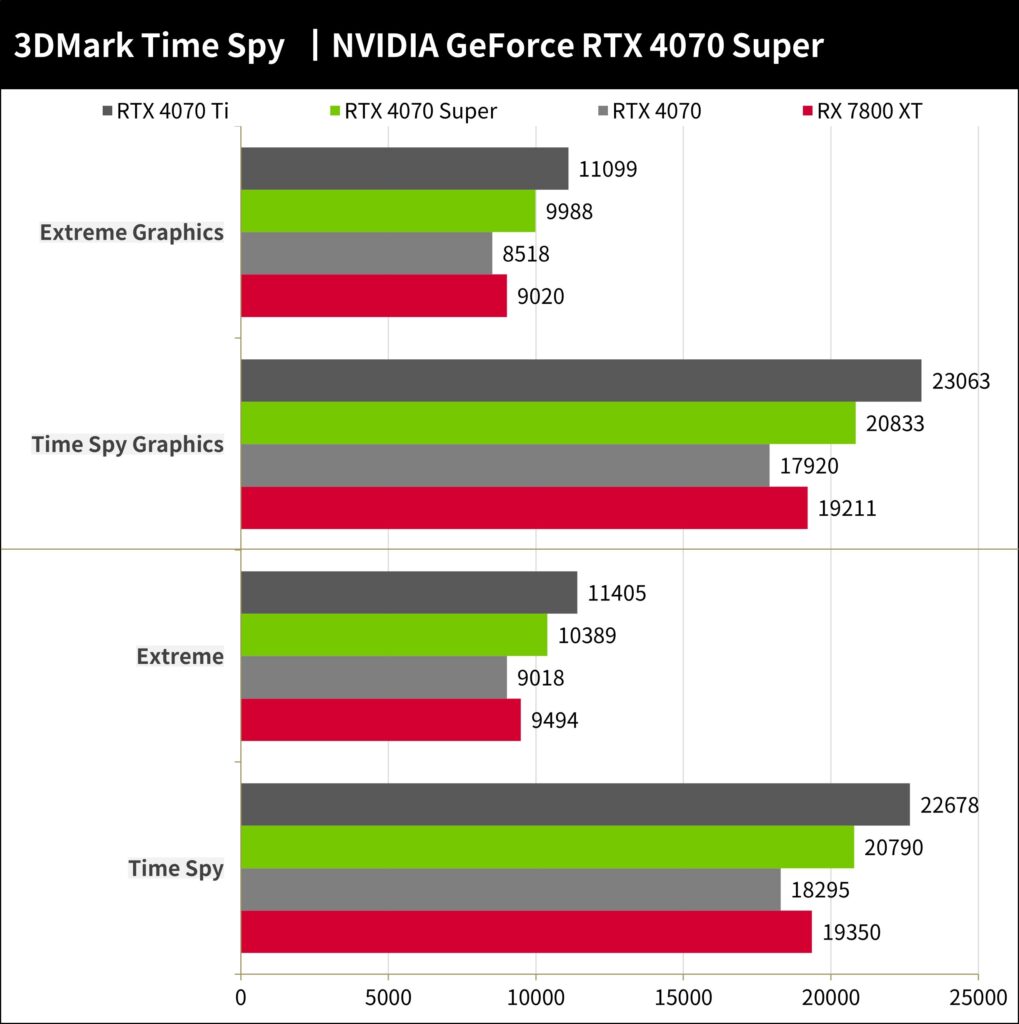
The 3DMark Time Spy benchmark graph indicates how different GPUs perform under DirectX 12 API tasks. The RTX 4070 Super’s scores in both the standard Time Spy and the more demanding Time Spy Extreme tests are quite strong, reflecting its capability to handle intensive graphics workloads. It performs slightly below the RTX 4070 Ti but shows a solid lead over the RTX 4070 and RX 7800 XT, demonstrating its position as a high-performing graphics card suitable for demanding gaming and rendering tasks at high resolutions.
The RTX 4070 Super’s performance in ray tracing benchmarks without DLSS enabled indicates solid results, with 60.12 FPS in 3DMark Port Royal, 62.11 FPS in DXR tests, and 52.04 FPS in the Speed Way scenario. These figures suggest a 17% improvement over the RTX 4070 in ray tracing tasks, while being approximately 8% behind the RTX 4070 Ti, showing that the 4070 Super is well-equipped for handling hardware-accelerated ray tracing in gaming scenarios.
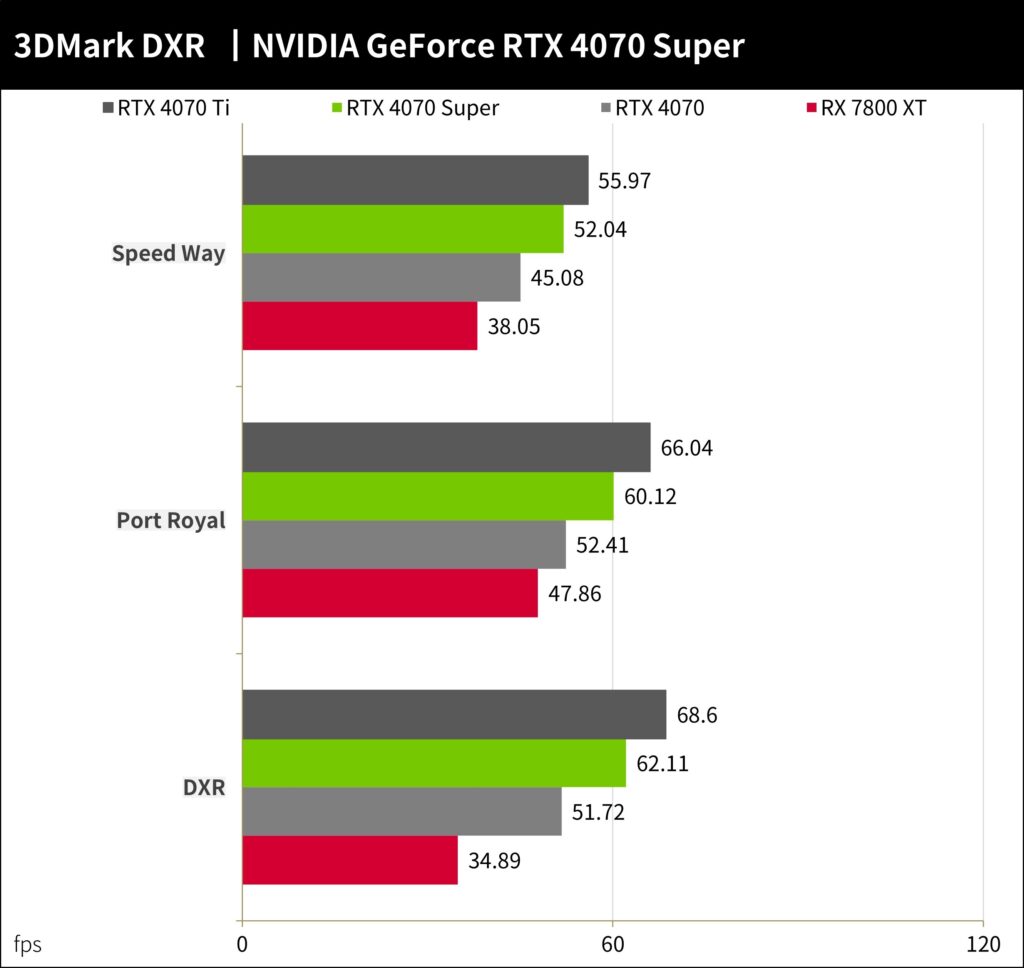
The graph displays FPS results for the RTX 4070 Ti, RTX 4070 Super, RTX 4070, and RX 7800 XT from the 3DMark suite of tests focused on DirectX Raytracing (DXR) performance. These benchmarks—Speed Way, Port Royal, and DXR—specifically test the ray-tracing capabilities of these GPUs. The RTX 4070 Super’s performance is solid across all tests, closely following the RTX 4070 Ti and outperforming the RTX 4070, indicating strong ray tracing capabilities.
The RTX 4070 Super demonstrates significant performance gains in the 3DMark DLSS Feature Test. With DLSS 2 enabled, it achieves 74.78 FPS, which translates to a 2.68x improvement. With DLSS 3, which utilizes AI frame generation techniques, it reaches even higher at 98.19 FPS, approximately a 3.5x increase in performance. These results highlight the card’s efficient use of DLSS technology to enhance frame rates at high resolutions, such as 3840 x 2160, and underperformance mode settings.
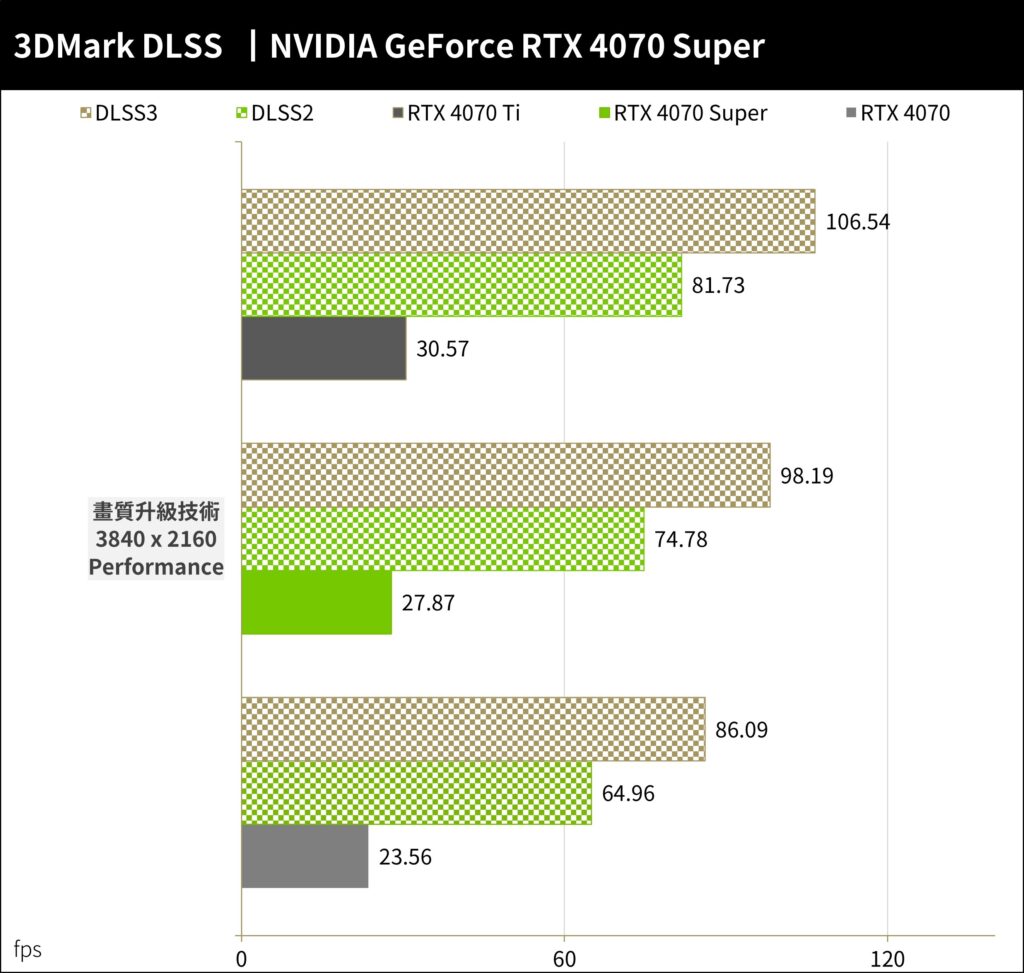
The graph presents FPS results for the 3DMark DLSS Feature Test at a 3840 x 2160 resolution in Performance mode. It compares the performance of DLSS 2 and DLSS 3 across various NVIDIA RTX GPUs. The RTX 4070 Super performs exceptionally well, especially with DLSS 3 enabled, achieving high frame rates and showing the significant impact of DLSS technology in enhancing gaming performance at ultra-high resolutions.
NVIDIA RTX 4070 Super Masters Esports: High FPS in Top Games at 1440p and 2160p
The RTX 4070 Super delivers strong performance in esports titles like “Rainbow Six: Siege,” “League of Legends,” “Apex Legends,” and “Counter-Strike 2,” which are games that prioritize skill and teamwork over high-end graphics. Even at 1440p or 2160p with the highest settings, the RTX 4070 Super provides sufficient frame rates, averaging above 100 FPS. It offers a 6-7% performance increase over the RTX 4070 and is only about 10% behind the RTX 4070 Ti, outperforming the RX 7800 XT in these gaming scenarios.
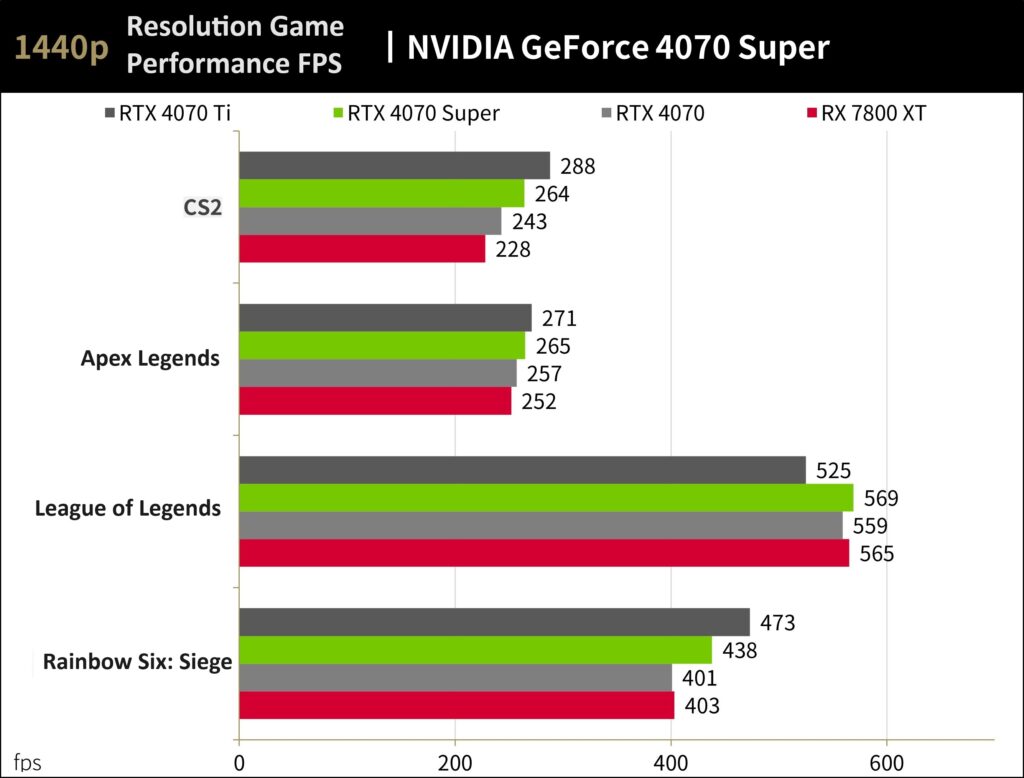
The graph showcases FPS benchmarks for various GPUs at a resolution of 1440p across multiple esports titles. The RTX 4070 Super performs exceptionally well, offering high frame rates that are essential for competitive gameplay. Its performance is slightly below the RTX 4070 Ti but ahead of the RTX 4070 and RX 7800 XT, emphasizing its strength in providing smooth gaming experiences at a demanding resolution in popular competitive games.
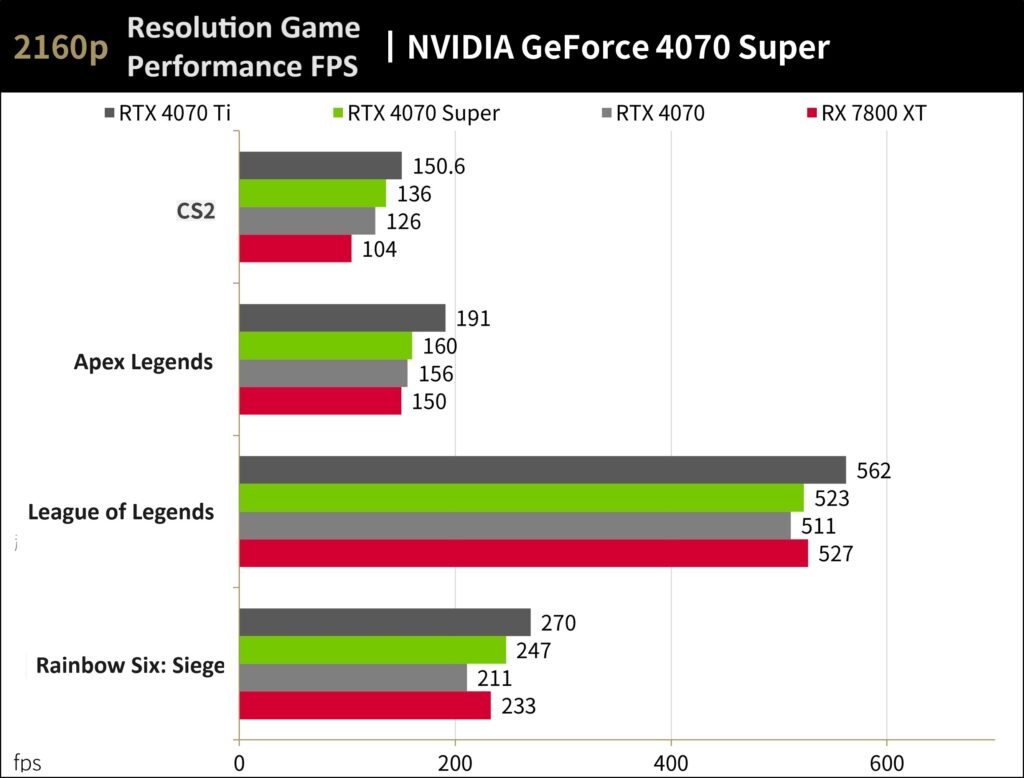
The graph indicates FPS benchmarks for 2160p (4K) gaming performance on various graphics cards including the RTX 4070 Ti, RTX 4070 Super, RTX 4070, and RX 7800 XT. At this higher resolution, the RTX 4070 Super maintains strong performance across popular esports titles, confirming its capability to deliver high-quality gaming experiences even at demanding 4K resolution.
NVIDIA RTX 4070 Super in AAA Gaming: High FPS Performance at 1440p and 2160p
The Nvidia GeForce RTX 4070 Super, compared to its predecessors and contemporaries, shows significant performance improvements. In 1440p gaming benchmarks, it surpasses the RTX 4070 by approximately 13%, delivering an average of 127.17 FPS, which is higher than the RTX 4070’s average of 112.43 FPS. Although it slightly underperforms compared to the RTX 4070 Ti (which averages 138.02 FPS), it outperforms the RX 7800 XT by about 6%, with the latter averaging 120.32 FPS. This showcases the RTX 4070 Super’s efficiency and power in traditional rendering game performances, especially in 1440p resolution gaming.
In 2160p (4K) resolution, the RTX 4070 Super shows a performance increase of approximately 14% over the RTX 4070, averaging 72.26 FPS compared to the latter’s 63.6 FPS. While it slightly underperforms against the RTX 4070 Ti, which averages 79.37 FPS, it does outperform the RX 7800 XT by around 8%. The RTX 4070 Super thus demonstrates a consistent performance improvement, making it a more suitable choice for entry-level 4K gaming. However, for optimal stability and smoothness in 4K, it’s recommended to use DLSS acceleration.
NVIDIA RTX 4070 Super Ray Tracing Performance: Stunning FPS in Top DXR Games at 1440p and 2160p
In a comprehensive evaluation featuring nine DXR ray-tracing games, key titles tested include the award-winning “The Witcher 3: Wild Hunt,” the newly released “Star Wars Jedi: Survivor” and “Hogwarts Legacy,” along with the NVIDIA-enhanced “Portal with RTX” ray-tracing edition. Additional popular games in the test suite were “Cyberpunk 2077,” “Control,” “Spider-Man: Miles Morales,” “Marvel’s Guardians of the Galaxy,” and “Far Cry 6.” These games were tested at both 1440p and 2160p resolutions with the highest settings for special effects and ray tracing, and the use of DLSS acceleration was also incorporated. For detailed settings, refer to the accompanying charts.
Focusing on the RTX 4070 Super’s performance at 1440p resolution with DLSS 3 acceleration, it delivered impressive frame rates: an average of 129 FPS in “The Witcher 3: Wild Hunt,” 122 FPS in “Portal with RTX,” and 146.3 FPS in “Cyberpunk 2077.” Across the nine ray-tracing games, the average frame rate achieved was 132.6 FPS.
When comparing the RTX 4070 Super at 1440p resolution, it showed an 11% improvement in ray-tracing game performance over the RTX 4070, averaging 119.5 FPS. However, it marked a decrease of approximately 9% in performance compared to the RTX 4070 Ti, which averaged 146 FPS.
For the higher-end 2160p (4K) resolution, the RTX 4070 Super showed an average frame rate of 78.4 FPS, representing a 10% improvement in gaming performance over the RTX 4070, which averaged 71 FPS. However, it fell short by about 10% compared to the RTX 4070 Ti, which averaged 87.3 FPS.
It’s important to note that the RTX 4070 Super does not consistently maintain over 60 FPS in all 4K ray-tracing games. Consequently, for gamers prioritizing 4K ray-tracing performance, it might be advisable to opt for the RTX 4070 Ti or to wait for the upcoming RTX 4070 Ti Super, which could offer a more suitable option.
Analyzing RTX 4070 Super Power and Temperature: In-Depth Testing with Stress Tests and Gaming
For the power consumption and temperature testing of graphics cards, a combination of the Speed Way Stress test, Furmark, and “Cyberpunk 2077” was used. Power consumption was measured using NVIDIA’s PACT tool, which monitors the wattage supplied by the PCIe slot and the 12V power supply.
In terms of temperature, the RTX 4070 Super Founders Edition maintained a peak temperature of 67.7°C during stress tests. During gameplay in “Cyberpunk 2077,” the temperature slightly decreased to 64°C. Compared to the original RTX 4070 and RTX 4070 Ti, the RTX 4070 Super runs a bit hotter, but still within an acceptable range.
During the Total Board Power (TBP) consumption tests, the RTX 4070 Super Founders Edition demonstrated varying power usage under different conditions. During the Speed Way Stress test, the card averaged a power consumption of 218.8W. In the Furmark 4K Xtreme burn-in test, it reached a peak of 217.1W. However, during gameplay in “Cyberpunk 2077,” the power consumption was slightly lower at 211.7W. This represents an increase of approximately 20W in power usage compared to the RTX 4070. Overall, there was no significant change in energy efficiency.
Summarize
The NVIDIA GeForce RTX 4070 Super offers a modest upgrade over its predecessor, delivering a 10% performance boost in 2K ray-tracing and DLSS-accelerated gaming at the same USD price point. For 3D rendering tasks, it shows an improvement of 18-23% and a 14% enhancement in Stable Diffusion TensorRT optimization. While it falls behind the RTX 4070 Ti by about 10% in performance, it still presents a compelling option.
In terms of pricing, the RTX 4070 Super is suggested to retail at TWD 21,990. This has led to a gradual price reduction of the existing RTX 4070 to TWD 18,990. When considering value for money, the discounted RTX 4070 appears to be a more cost-effective choice. However, for entry-level 4K gamers, the RTX 4070 Super, with its superior performance, might be the recommended option.
For gamers with a higher budget, waiting for the release of the RTX 4070 Ti Super could be worthwhile. This upcoming model is expected to set a new standard for 4K60 gaming graphics cards.
If this article is helpful for you, please share this article with your friends on social media. Thank you!
This article is based on the personality of the reviews. You are responsible for fact-checking if the contents are not facts or accurate.
Title: Introducing the NVIDIA GeForce RTX 4070 Super: A Comprehensive Guide to the Latest Enhancements in the RTX 40 Super Series